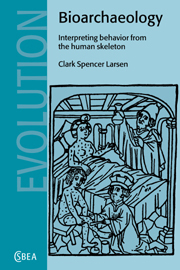Book contents
- Frontmatter
- Contents
- Acknowledgments
- 1 Introduction
- 2 Stress and deprivation during the years of growth and development and adulthood
- 3 Exposure to infectious pathogens
- 4 Injury and violent death
- 5 Activity patterns: 1. Articular and muscular modifications
- 6 Activity patterns: 2. Structural adaptation
- 7 Masticatory and nonmasticatory functions: craniofacial adaptation
- 8 Isotopic and elemental signatures of diet and nutrition
- 9 Historical dimensions of skeletal variation: tracing genetic relationships
- 10 Changes and challenges in bioarchaeology
- References
- General index
- Site index
9 - Historical dimensions of skeletal variation: tracing genetic relationships
Published online by Cambridge University Press: 05 June 2012
- Frontmatter
- Contents
- Acknowledgments
- 1 Introduction
- 2 Stress and deprivation during the years of growth and development and adulthood
- 3 Exposure to infectious pathogens
- 4 Injury and violent death
- 5 Activity patterns: 1. Articular and muscular modifications
- 6 Activity patterns: 2. Structural adaptation
- 7 Masticatory and nonmasticatory functions: craniofacial adaptation
- 8 Isotopic and elemental signatures of diet and nutrition
- 9 Historical dimensions of skeletal variation: tracing genetic relationships
- 10 Changes and challenges in bioarchaeology
- References
- General index
- Site index
Summary
Introduction
Relatedness between human groups has long been a point of discussion in anthropology, especially in historical studies of earlier societies. Biological distance, or ‘biodistance’, is the measurement and interpretation of relatedness or divergence between populations or subgroups within populations based on analysis of polygenie skeletal and dental traits (Buikstra et al., 1990). The degree of relatedness presupposes that populations sharing attributes are more closely related than populations expressing many differences.
Biodistance analysis is complex, especially with regard to identifying meaningful patterns of biological variation that distinguish between populations, either in temporal succession or geographic distribution. Because of the complex nature of pattern identification, a great deal of attention has been devoted to methodological and theoretical concerns (e.g., Berry & Berry, 1967; Finnegan & Cooprider, 1978; Hauser & De Stefano, 1989; Heathcote, 1986; Hillson, 1986, 1996; Howells, 1973, 1989; Mayhall, 1992; Molto, 1983; Rösing, 1982, 1984; Saunders, 1989; Sjøvold, 1977; van Vark, 1970; van Vark & Howells, 1984).
Close biological affinity is indicated by unusually high (or sometimes low) frequencies of specific traits in some populations (e.g., Hrdlička, 1935; Larsen, Craig et al., 1995; Nelson, 1992; Snow, 1974) or within subgroups of populations (e.g., Spence, 1994). Inter- and intrapopulation biological relationships are mostly identified on the basis of the simultaneous consideration of multiple traits via multivariate statistical analysis commonly involving the determination of principal components, discriminant function, or biodistance statistics, and subsequent cluster analysis or multidimensional scaling.
- Type
- Chapter
- Information
- BioarchaeologyInterpreting Behavior from the Human Skeleton, pp. 302 - 332Publisher: Cambridge University PressPrint publication year: 1997



